

Compact Muon Solenoid
LHC, CERN
| CMS-EXO-17-022 ; CERN-EP-2018-094 | ||
| Search for pair-produced resonances each decaying into at least four quarks in proton-proton collisions at $\sqrt{s} = $ 13 TeV | ||
| CMS Collaboration | ||
| 4 June 2018 | ||
| Phys. Rev. Lett. 121 (2018) 141802 | ||
| Abstract: This letter presents the results of a search for pair-produced particles of masses above 100 GeV that each decay into at least four quarks. Using data collected by the CMS experiment at the LHC in 2015-2016, corresponding to an integrated luminosity of 38.2 fb$^{-1}$, reconstructed particles are clustered into two large jets of similar mass, each consistent with four-parton substructure. No statistically significant excess of data over the background prediction is observed in the distribution of average jet mass. Pair-produced squarks with dominant hadronic $R$-parity-violating decays into four quarks and with masses between 0.10 and 0.72 TeV are excluded at 95% confidence level. Similarly, pair-produced gluinos that decay into five quarks are also excluded with masses between 0.10 and 1.41 TeV at 95% confidence level. These are the first constraints that have been placed on pair-produced particles with masses below 400 GeV that decay into four or five quarks, bridging a significant gap in the coverage of $R$-parity-violating supersymmetry parameter space. | ||
| Links: e-print arXiv:1806.01058 [hep-ex] (PDF) ; CDS record ; inSPIRE record ; CADI line (restricted) ; | ||
| Figures & Tables | Summary | Additional Figures | References | CMS Publications |
|---|
| Figures | |

png pdf |
Figure 1:
Leading order Feynman diagrams for a squark decaying into four quarks via an intermediate higgsino and a three-body decay involving an off-shell squark with an RPV coupling (left) and for a gluino decaying into five quarks via a three-body decay into two quarks and a higgsino, which decays into three quarks as in the squark case (right). This analysis assumes that the initial squarks (or gluinos) are pair-produced and that they each decay as presented. |
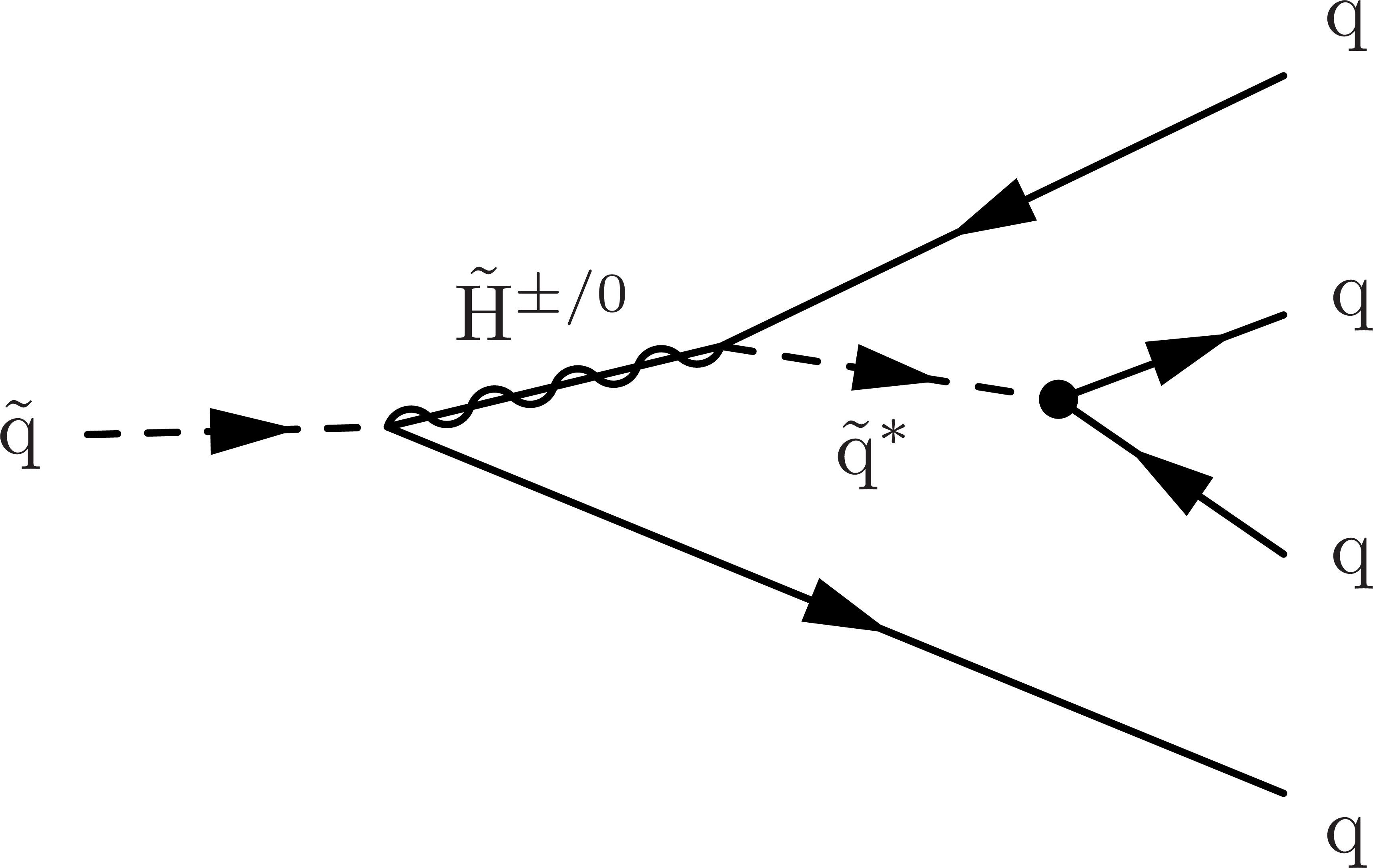
png pdf |
Figure 1-a:
Leading order Feynman diagram for a squark decaying into four quarks via an intermediate higgsino and a three-body decay involving an off-shell squark with an RPV coupling. This analysis assumes that the initial squarks are pair-produced and that they each decay as presented. |
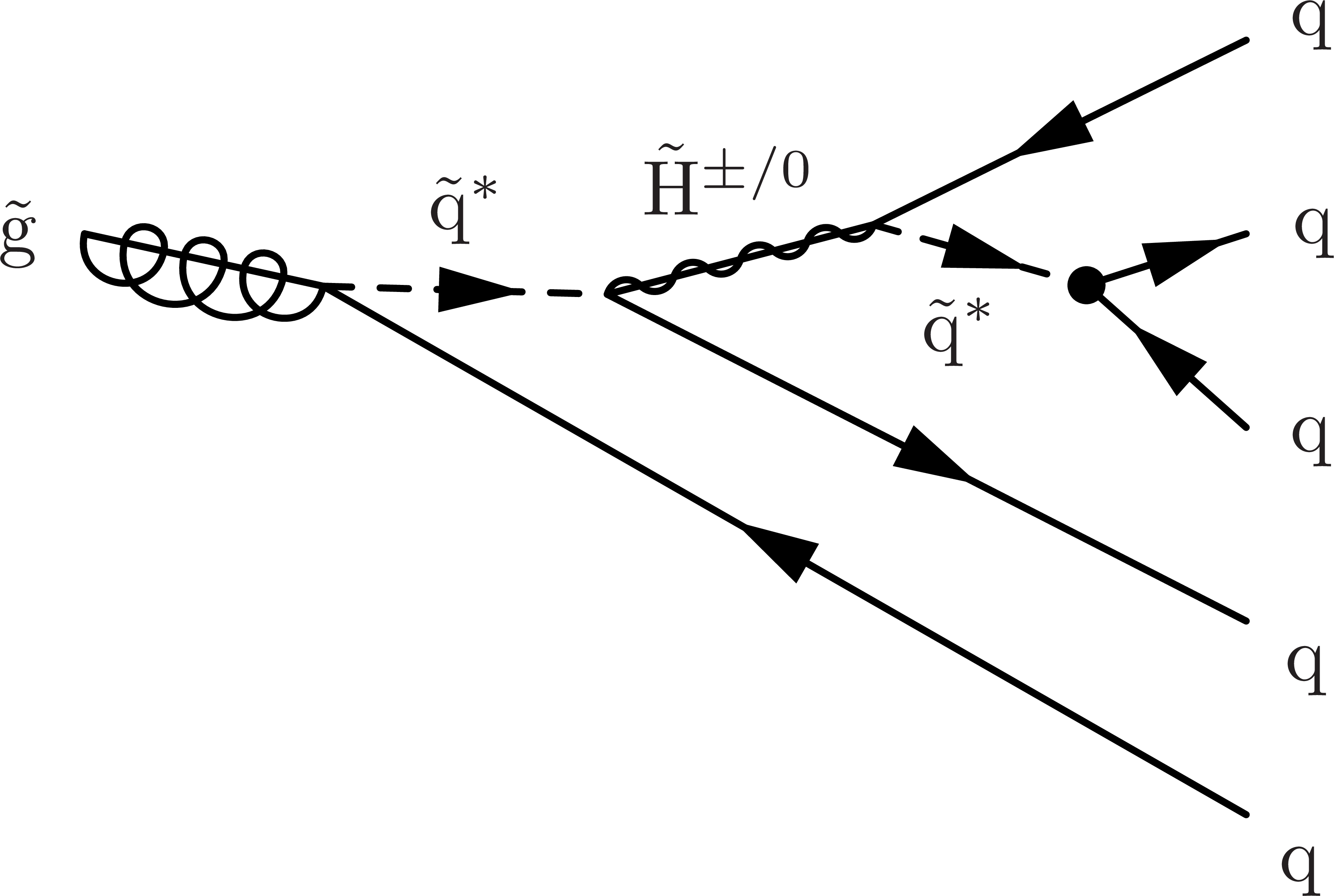
png pdf |
Figure 1-b:
Leading order Feynman diagram for a gluino decaying into five quarks via a three-body decay into two quarks and a higgsino, which decays into three quarks as in the squark case. This analysis assumes that the initial gluinos are pair-produced and that they each decay as presented. |
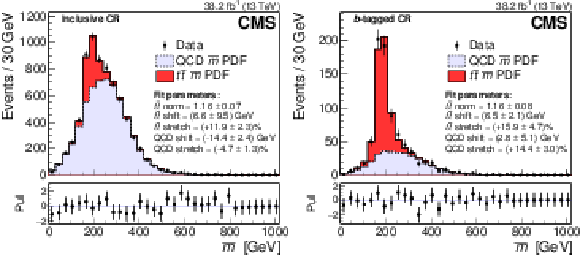
png pdf |
Figure 2:
The background estimation results in the inclusive CR (left) and b-tagged CR (right). The relevant fit parameters are displayed on each plot. The pull of each $ {\overline {m}} $ bin is the difference of the value of the data $ {\overline {m}} $ distribution and the value of the combined background post-fit $ {\overline {m}} $ PDF, divided by the statistical uncertainty. |
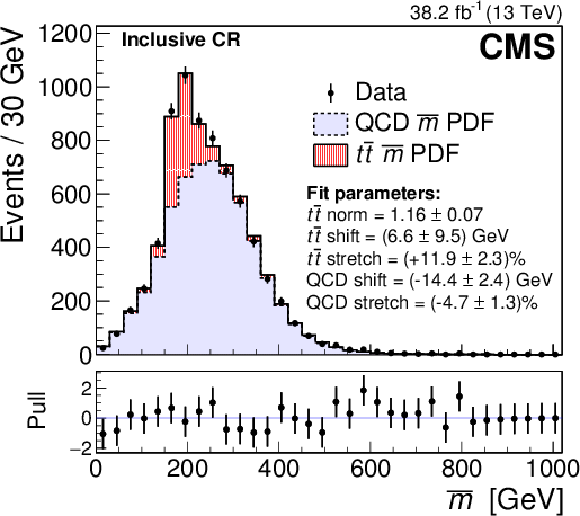
png pdf |
Figure 2-a:
The background estimation results in the inclusive CR. The relevant fit parameters are displayed. The pull of each $ {\overline {m}} $ bin is the difference of the value of the data $ {\overline {m}} $ distribution and the value of the combined background post-fit $ {\overline {m}} $ PDF, divided by the statistical uncertainty. |
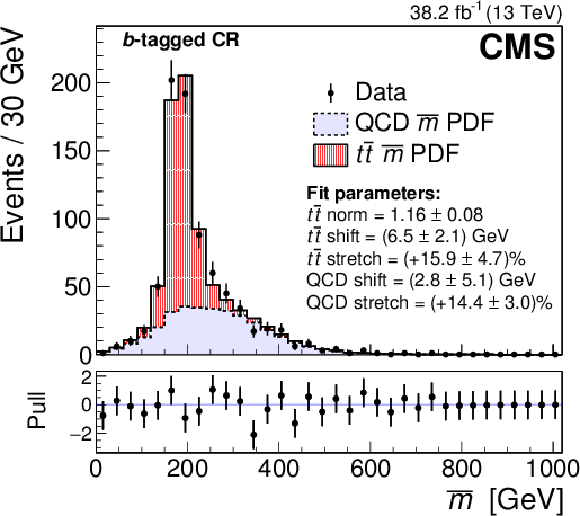
png pdf |
Figure 2-b:
The background estimation results in the b-tagged CR. The relevant fit parameters are displayed. The pull of each $ {\overline {m}} $ bin is the difference of the value of the data $ {\overline {m}} $ distribution and the value of the combined background post-fit $ {\overline {m}} $ PDF, divided by the statistical uncertainty. |

png pdf |
Figure 3:
Left: a comparison between the QCD multijet $ {\overline {m}} $ PDF and the tagged fat-jet pair selection in simulated QCD multijet events that pass the signal selection. The pull of each $ {\overline {m}} $ bin is the difference of the value of the fat-jet pair $ {\overline {m}} $ distribution and the value of the post-fit $ {\overline {m}} $ PDF, divided by the statistical uncertainty. Right: distributions in $ {\overline {m}} $, including the predicted (post-fit) background contributions. Shown also are the signals from squarks with masses of 100 GeV and 500 GeV. The pull of each $ {\overline {m}} $ bin is the difference of the value of the data $ {\overline {m}} $ distribution and the value of the background prediction, divided by the statistical uncertainty. |
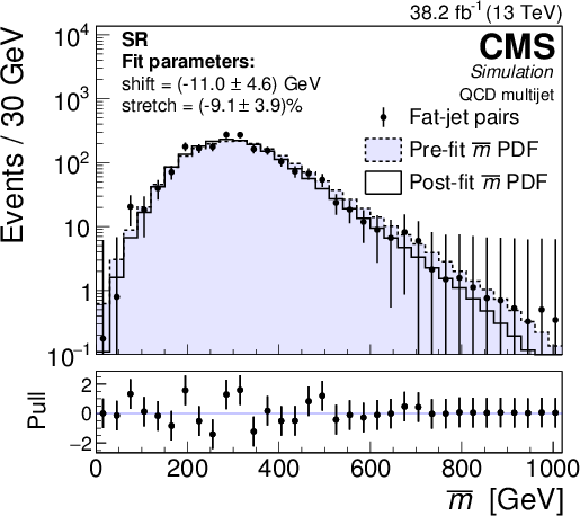
png pdf |
Figure 3-a:
A comparison between the QCD multijet $ {\overline {m}} $ PDF and the tagged fat-jet pair selection in simulated QCD multijet events that pass the signal selection. The pull of each $ {\overline {m}} $ bin is the difference of the value of the fat-jet pair $ {\overline {m}} $ distribution and the value of the post-fit $ {\overline {m}} $ PDF, divided by the statistical uncertainty. |

png pdf |
Figure 3-b:
Distributions in $ {\overline {m}} $, including the predicted (post-fit) background contributions. Shown also are the signals from squarks with masses of 100 GeV and 500 GeV. The pull of each $ {\overline {m}} $ bin is the difference of the value of the data $ {\overline {m}} $ distribution and the value of the background prediction, divided by the statistical uncertainty. |

png pdf |
Figure 4:
The expected and observed limits on the product of the pair-production cross section and branching fraction squared for a quark decaying to four quarks (left) and for a gluino decaying to five quarks (right). |
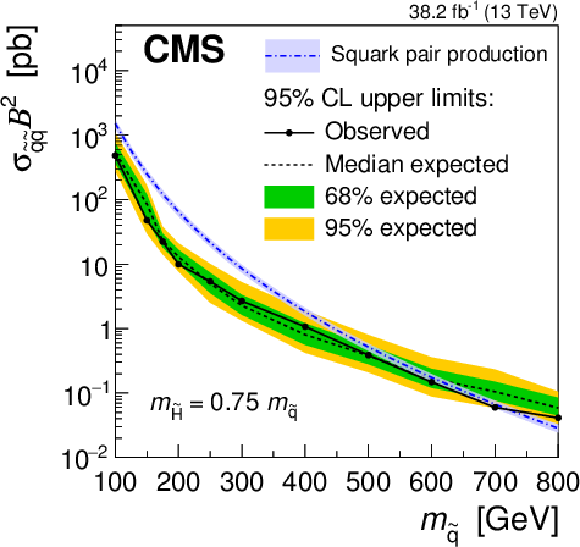
png pdf |
Figure 4-a:
The expected and observed limits on the product of the pair-production cross section and branching fraction squared for a quark decaying to four quarks. |

png pdf |
Figure 4-b:
The expected and observed limits on the product of the pair-production cross section and branching fraction squared for a gluino decaying to five quarks. |
| Tables | |
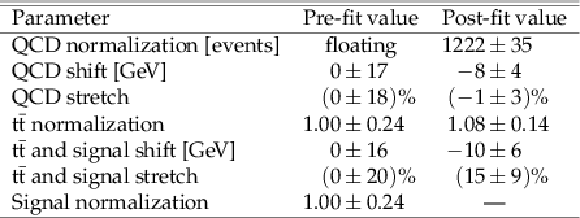
png pdf |
Table 1:
The nuisance parameters corresponding to each rate and shape parameter of the background and signal distributions, before and after the maximum-likelihood fit. Except for the QCD multijet $ {\overline {m}} $ PDF normalization, which is floating (and the value of which is simply the event yield with its statistical uncertainty), each nuisance parameter has a Gaussian prior PDF and is reported with the given mean and standard deviation. |
| Summary |
| In summary, a search has been conducted at the LHC for light pair-produced resonances that each decay into at least four quarks. No statistically significant excess over the expectation is observed. The data impose limits on $R$-parity-violating supersymmetry pair production [15], excluding squark masses between 0.10 and 0.72 TeV and gluino masses between 0.10 and 1.41 TeV. These are the first constraints that have been placed on pair-produced particles with masses below 400 GeV that decay into four or five quarks, bridging a significant gap in the coverage of $R$-parity-violating supersymmetry parameter space. This analysis is sufficiently general that it can be applied to other models describing pair-produced particles decaying into four or more detectable objects. |
| Additional Figures | |

png pdf |
Additional Figure 1:
Acceptance and acceptance times efficiency in the SR for the simulated squark and gluino signal samples. |
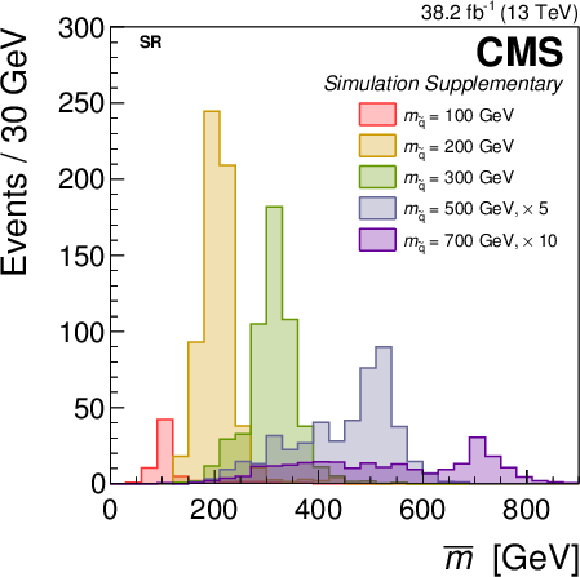
png pdf |
Additional Figure 2:
Distributions in ${\overline {m}}$ in the SR for a selection of simulated squark signal samples. |
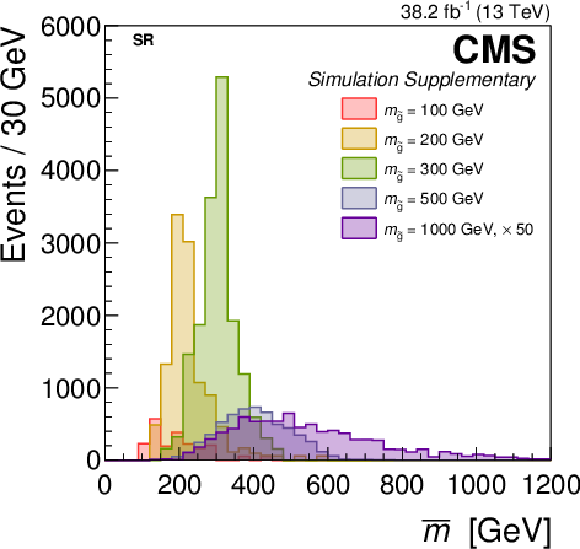
png pdf |
Additional Figure 3:
Distributions in ${\overline {m}}$ in the SR for a selection of simulated gluino signal samples. |

png pdf |
Additional Figure 4:
Distributions in ${\overline {m}}$ for the tagged ${p_{\mathrm {T}}}$ -leading fat jets $P(m)$ in the SR and the ${\overline {m}}$ PDFs derived from these fat jets with and without ${H_{\mathrm {T}}}$ reweighting. |
| References | ||||
| 1 | E. Witten | Dynamical breaking of supersymmetry | NPB 188 (1981) 513 | |
| 2 | S. Dimopoulos and H. Georgi | Softly broken supersymmetry and SU(5) | NPB 193 (1981) 150 | |
| 3 | Y. A. Gol'fand and E. P. Likhtman | Extension of the algebra of Poincar$ \'e $ group generators and violation of P invariance | JEPTL 13 (1971) 323 | |
| 4 | J. Wess and B. Zumino | Supergauge transformations in four dimensions | NPB 70 (1974) 39 | |
| 5 | H. P. Nilles | Supersymmetry, supergravity and particle physics | PR 110 (1984) 1 | |
| 6 | R. Barbieri, S. Ferrara, and C. A. Savoy | Gauge models with spontaneously broken local supersymmetry | PLB 119 (1982) 343 | |
| 7 | S. Dimopoulos, S. Raby, and F. Wilczek | Supersymmetry and the scale of unification | PRD 24 (1981) 1681 | |
| 8 | L. E. Ibanez and G. G. Ross | Low-energy predictions in supersymmetric grand unified theories | PLB 105 (1981) 439 | |
| 9 | W. J. Marciano and G. Senjanovi\'c | Predictions of supersymmetric grand unified theories | PRD 25 (1982) 3092 | |
| 10 | R. Barbieri and G. F. Giudice | Upper bounds on supersymmetric particle masses | NPB 306 (1988) 63 | |
| 11 | R. Kitano and Y. Nomura | Supersymmetry, naturalness, and signatures at the LHC | PRD 73 (2006) 095004 | hep-ph/0602096 |
| 12 | C. Brust, A. Katz, S. Lawrence, and R. Sundrum | SUSY, the Third Generation and the LHC | JHEP 03 (2012) 103 | 1110.6670 |
| 13 | M. Papucci, J. T. Ruderman, and A. Weiler | Natural SUSY endures | JHEP 09 (2012) 035 | 1110.6926 |
| 14 | G. R. Farrar and P. Fayet | Phenomenology of the production, decay, and detection of new hadronic states associated with supersymmetry | PLB 76 (1978) 575 | |
| 15 | J. A. Evans and Y. Kats | LHC coverage of RPV MSSM with light stops | JHEP 04 (2013) 028 | 1209.0764 |
| 16 | R. Barbier et al. | $ R $-parity-violating supersymmetry | Phys. Rep. 420 (2005) 1 | hep-ph/0406039 |
| 17 | CMS Collaboration | Search for new phenomena in events with high jet multiplicity and low missing transverse momentum in proton-proton collisions at $ \sqrt{s}= $ 8 ~TeV | PLB 770 (2017) 257 | CMS-EXO-13-001 1608.01224 |
| 18 | CMS Collaboration | Searches for $ R $-parity-violating supersymmetry in pp collisions at $ \sqrt{s}= $ 8 ~TeV in final states with 0--4 leptons | PRD 94 (2016) 112009 | CMS-SUS-14-003 1606.08076 |
| 19 | ATLAS Collaboration | Search for new phenomena in final states with large jet multiplicities and missing transverse momentum with ATLAS using $ \sqrt{s}= $ 13 ~TeV proton-proton collisions | PLB 757 (2016) 334 | 1602.06194 |
| 20 | ATLAS Collaboration | Search for massive supersymmetric particles decaying to many jets using the ATLAS detector in pp collisions at $ \sqrt{s}= $ 8 ~TeV | PRD 91 (2015) 112016 | 1502.05686 |
| 21 | CMS Collaboration | Search for low mass vector resonances decaying into quark-antiquark pairs in proton-proton collisions at $ \sqrt{s}= $ 13 ~TeV | JHEP 01 (2018) 097 | CMS-EXO-17-001 1710.00159 |
| 22 | ATLAS Collaboration | A search for pair-produced resonances in four-jet final states at $ \sqrt{s}= $ 13 ~TeV with the ATLAS detector | EPJC 78 (2018) 250 | 1710.07171 |
| 23 | CMS Collaboration | Search for pair-produced resonances decaying to jet pairs in proton-proton collisions at $ \sqrt{s}= $ 8 ~TeV | PLB 747 (2015) 98 | CMS-EXO-12-052 1412.7706 |
| 24 | ATLAS Collaboration | A search for top squarks with R-parity-violating decays to all-hadronic final states with the ATLAS detector in $ \sqrt{s}= $ 8 ~TeV proton-proton collisions | JHEP 06 (2016) 67 | 1601.07453 |
| 25 | CMS Collaboration | The CMS trigger system | JINST 12 (2017) P01020 | CMS-TRG-12-001 1609.02366 |
| 26 | CMS Collaboration | The CMS experiment at the CERN LHC | JINST 3 (2008) S08004 | CMS-00-001 |
| 27 | CMS Collaboration | Particle-flow reconstruction and global event description with the CMS detector | JINST 12 (2017) P10003 | CMS-PRF-14-001 1706.04965 |
| 28 | M. Cacciari, G. P. Salam, and G. Soyez | FastJet user manual | EPJC 72 (2012) 1896 | 1111.6097 |
| 29 | G. P. Salam | Towards jetography | EPJC 67 (2010) 637 | 0906.1833 |
| 30 | J. Alwall et al. | The automated computation of tree-level and next-to-leading order differential cross sections, and their matching to parton shower simulations | JHEP 07 (2014) 079 | 1405.0301 |
| 31 | NNPDF Collaboration | Parton distributions with LHC data | NPB 867 (2013) 244 | 1207.1303 |
| 32 | T. Sjostrand et al. | An introduction to PYTHIA 8.2 | CPC 191 (2015) 159 | 1410.3012 |
| 33 | CMS Collaboration | Event generator tunes obtained from underlying event and multiparton scattering measurements | EPJC 76 (2016) 155 | CMS-GEN-14-001 1512.00815 |
| 34 | C. Borschensky et al. | Squark and gluino production cross sections in pp collisions at $ \sqrt{s}= $ 13 , 14, 33 and 100~TeV | EPJD 74 (2014) 3174 | 1407.5066 |
| 35 | P. Nason | A new method for combining NLO QCD with shower Monte Carlo algorithms | JHEP 11 (2004) 040 | hep-ph/0409146 |
| 36 | S. Frixione, P. Nason, and C. Oleari | Matching NLO QCD computations with parton shower simulations: the POWHEG method | JHEP 11 (2007) 070 | 0709.2092 |
| 37 | S. Alioli, P. Nason, C. Oleari, and E. Re | A general framework for implementing NLO calculations in shower Monte Carlo programs: the POWHEG BOX | JHEP 06 (2010) 043 | 1002.2581 |
| 38 | CMS Collaboration | Measurement of differential cross sections for top quark pair production using the $ \text{lepton}+\text{jets} $ final state in proton-proton collisions at 13~TeV | PRD 95 (2017) 092001 | CMS-TOP-16-008 1610.04191 |
| 39 | CMS Collaboration | Jet energy scale and resolution in the CMS experiment in pp collisions at 8 TeV | JINST 12 (2017) P02014 | CMS-JME-13-004 1607.03663 |
| 40 | CMS Collaboration | Identification and filtering of uncharacteristic noise in the CMS hadron calorimeter | JINST 5 (2010) T03014 | CMS-CFT-09-019 0911.4881 |
| 41 | CMS Collaboration | Jet algorithms performance in 13~TeV data | CMS-PAS-JME-16-003 | CMS-PAS-JME-16-003 |
| 42 | J. Thaler and K. Van Tilburg | Maximizing boosted top identification by minimizing $ N $-subjettiness | JHEP 02 (2012) 093 | 1108.2701 |
| 43 | S. D. Ellis, C. K. Vermilion, and J. R. Walsh | Recombination algorithms and jet substructure: pruning as a tool for heavy particle searches | PRD 81 (2010) 094023 | 0912.0033 |
| 44 | CMS Collaboration | Identification of heavy-flavour jets with the CMS detector in pp collisions at 13 TeV | JINST 13 (2018) P05011 | CMS-BTV-16-002 1712.07158 |
| 45 | Particle Data Group, C. Patrignani et al., ``Review of particle physics'', Chin. Phys. C 40 (2016) 100001, .See Ch. 39 | Review of particle physics | ||
| 46 | M. Metropolis et al. | Equation of state calculations by fast computing machines | J. Chem. Phys. 21 (1953) 1087 | |

|
Compact Muon Solenoid LHC, CERN |

|

|

|

|

|

|